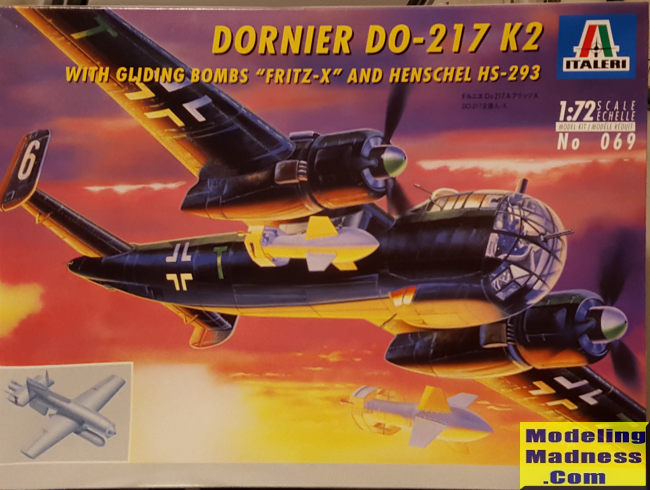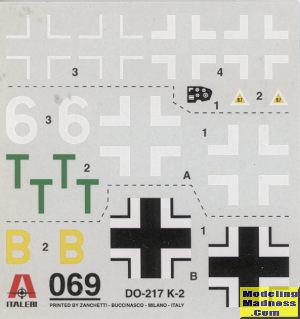
Italeri 1/72 Do-217K-2
| KIT #: | 069 |
| PRICE: | $ |
| DECALS: | Two options |
| REVIEWER: | Scott Van Aken |
| NOTES: | Old school tooling with raised panel lines |

| HISTORY |
To replace the Do 217, the RLM planned for the He 177 A-3 and A-5 to be the long-range carrier aircraft for missiles, owing to the lack of BMW engines to power the Dornier but problems with the engine reliability of the He 177A led to the failure of the plan. The Battle of Stalingrad used up more and more aircrew which prevented them retraining on the Do 217 for glide bomb operations. Owing to the problems with the He 177A, Air Inspector General Erhard Milch returned his attention to the Do 217 and demanded a greater number of improved variants for Precision-guided munition (PGM) operations.
In early 1942, tests on a new and improved, completely glazed cockpit for the Do 217 series had been underway at the Hamburger Schiffbauanstalt (Hamburg Shipbuilding Institute). E-2s were fitted with a new streamlined "stepless cockpit" following its conceptual debut in January 1938 for the He 111P, as this design philosophy became the standard for almost all German bombers later in World War II, which eliminated the separate windscreen panels for the pilot of earlier versions of the Do 217. The lower nose of the K-version also retained the Bola inverted-casemate gondola for a rearwards-aimed ventral defensive armament emplacement, with its forward end fully incorporated with the new nose glazing design. The testing for this new well-framed cockpit glazing format for the later models of the Do 217, was carried out at the Shipbuilding Institute in Hamburg. The design of the cockpit was put to the test using water pressure to simulate a speed of 700 km/h. Only a few of the glass panels failed, caused by inadequate mounting. The cabin design passed the tests easily. Initial flights took place on 31 March 1942 after teething problems had been resolved. The Do 217 K V1 flew with BMW 801A-1s from Löwenthal and Erprobungsstelle Rechlin. This was followed by the ten-airframe pre-production batch, Do 217 K-01 to K-010. Mass production of the Do 217 K-1 began at the Dornier factory at Wismar.
The first prototype, a modified E-2 flew on 31 March 1942, with the aircraft showing higher maximum speed owing to reduced drag. The Do 217 K entered production from September 1942. BMW believed that the type could reach an operational ceiling of 7,000 m, notwithstanding an A.U.W of 16.8 tonnes. Tests at Peenemünde in June and July 1943 showed that while the Do 217K could carry and deploy a Fritz-X PGM, it was still controllable.
The Do 217 K-2, was a specialized anti-shipping version based on the K-1, the Do 217 K-2 was intended to carry the Fritz X guided bomb, being fitted with pylon-faired hardpoints to allow carriage of two Fritz Xs inboard of the engines and the appropriate FuG 203 Kehl guidance system transmitter emplacement. It had longer-span wings (24.8 m (81 ft 41⁄2 in) compared with 19 m (62 ft 4 in) for the K-1) to give better high-altitude performance when carrying the heavy Fritz-X bombs. 50 were converted from K-1 airframes. The wing area was expanded by a total of 67 m2, but most of the K-2s internal equipment was the same as the K-1. The increase in area was to increase high-altitude performance. Some of the K-2s had a rigid tail MG 81Z which was not especially effective. It was loaded with 350 rounds and controlled by the use of a rear-facing telescope mounted in the forward section of the canopy left of the pilot. Either the gunners or pilot could fire the weapon, which could be jettisoned in case of an emergency to reduce weight.
| THE KIT |
 This
is not a new kit, as is evident by its raised panel lines. The kit also
shows evidence of a bit of flash on some parts, but overall the molds appear
to be in pretty good shape. The original Do-217K-1 kit came out in 1977 but
it took until 1996 for the long wing K-2 to finally hit the market. Note
that everything on the right side of the parts image is what has been added
to the K-1 kit.
This
is not a new kit, as is evident by its raised panel lines. The kit also
shows evidence of a bit of flash on some parts, but overall the molds appear
to be in pretty good shape. The original Do-217K-1 kit came out in 1977 but
it took until 1996 for the long wing K-2 to finally hit the market. Note
that everything on the right side of the parts image is what has been added
to the K-1 kit.  ght
model. The engines are pretty horrible, being simply flat plates, but since
the engine opening is covered by a fan, this isn't an issue. You are
provided covers for the exhaust if you wish to use them.
ght
model. The engines are pretty horrible, being simply flat plates, but since
the engine opening is covered by a fan, this isn't an issue. You are
provided covers for the exhaust if you wish to use them.| CONCLUSIONS |
So this one may have rather limited appeal due to the need to cut and hack as well as the raised panel lines. However, there is no other option for this aircraft in this scale. I certainly don't see many of them built, and it is a bit of a shame as Italeri kits do make into fairly nice models.
| REFERENCES |
https://en.wikipedia.org/wiki/Dornier_Do_217#Do_217_K
February 2020
Copyright ModelingMadness.com. All rights reserved. If you would like your product reviewed fairly and fairly quickly, please
contact
the editor or see other details in the
Note to
Contributors. Back to the Main Page
Back to the Review
Index Page
Back to the Previews Index Page